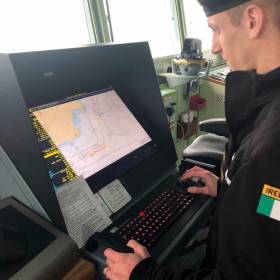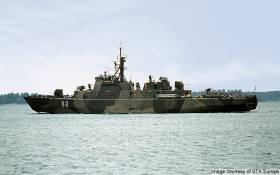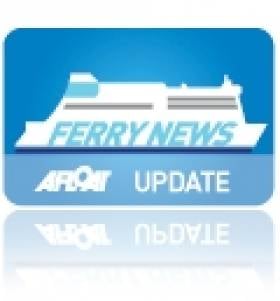Displaying items by tag: Flagship
Irish Naval Service Flagship First to Achieve "Paperless Navigation”
#NavalService - The Irish Naval Service flagship LÉ Eithne has recently been accredited as the first in the fleet to achieve "paperless navigation” writes Jehan Ashmore
The 1984 custom-built P30 class Helicopter Patrol Vessel (HPV), Afloat adds notably the last Irish built vessel for the Naval Service and of any ship in the Republic, now has Warship Electronic Chart Display and Information System (WECDIS).
The milestone took place this day last week, where the electronic systems according to the INS will greatly enhance navigation safety, situation awareness & tactical planning capabilities.
L.É Eithne is in the same company of the ageing P40's Coastal Patrol Vessel (CPV) pair, L.É. Orla and L.É. Ciara which also date to 1984, though they were originally commissioned for the UK Royal Navy.
The remaining patrol vessels of the fleet are all Offshore Patrol Vessels (OPV), beginning with the elder pair of P50 Róisín class L.É. Róisín and L.É Niamh, the latter completed in 2000. The reference to '80' refers to the length overall (LOA) of each of the sisters built by Appledore Shipbuilders, north Devon.
They are to recieve mid-life extension survey refits involving a Scottish marine consultancy firm.
A further trio, known as enhanced Róisín class followed suit, again from the same UK shipbuilder site but under management of Babcock Marine. They are the P60 OPV90's L.É. Samuel Beckett, James Joyce and William Butler Yeats.
The latest newbuild, again a OPV90 class, L.É. George Bernard Shaw was completed this year, though it would appear that the 2,250 tonnes vessel is the final to be built at the yard, following announcement of closure.
L.É. George Bernard Shaw is currently not part of the 8-strong fleet. As reported earlier this year, the €67m OPV newbuild is according to the IDF to be formally named and officially commissioned into the Naval Service this year.
Plans are afoot to replace LÉ Eithne with a new Multi Role Vessel MRV (a first for the INS), following the Budget, where total Defence spending across the three branch forces (air corps, army and navy) is to increase to €946m next year.
Finland 100: Naval Flagship Minelayer to Visit Dublin
#FinnishFlagship - Finnish Navy flagship FNS Hämeenmaa will be visiting Dublin Port as part of celebrations to mark the centenary year of the Nordic nation’s independence, writes Jehan Ashmore.
The visit of the minelayer flagship to the capital this week (24th-27th May) is to follow the Finnish Navy´s annual training exercises held in the Baltic Sea, North Sea and the Atlantic.
There will be a unique opportunity to visit the Finnish Naval ship as an ‘open ship’ event is organised for this Wednesday, May 24th between 17.00 and 18.30. The flagship will be docked at Sir John Rogerson's Quay.
The Finnish Navy has bases in Turku, Kirkkonummi, Raseborg and the capital, Helsinki with a combined crew of around 1400. The theme of the Finnish Defence Forces' Finland 100 Jubilee Year is National defence is everybody's business.
FNS Hämeenmaa is the leadship of her namesake class of a pair of 77m minelayers, the sister is FNS Uusimaa. The flagship which has a crew of 60 was built in 1992 by Finnyards, Rauma in south-west Finland. Only last year the 1,300 displacement minelayer was modernised. The yard is currently under ownership of STX Finland Cruise Oy.
Both minelayers during the mid 2000's underwent a major upgrade at Aker Finnyards (now part of STX) that had yards in Rauma, Turku and Helsinki. The Aker group was contracted by ICG parent company of Irish Ferries, to build the cruiseferry Ulysses. The Irish Ferries flagship entered the Welsh service to Holyhead in 2001.
Seasonal Services Set Sail ‘Four’ France
Also operating on the same route to Normandy are Celtic Link Ferries which run the modern sleek Italian built 800 passenger /200 vehicle ro-pax ferry Norman Voyager. Short wine breaks are from €200 return for a car, driver and a two-berth outside cabin. Additional passengers can travel for €10 each way and subject to sailing schedules passengers can stay in Cherbourg for up to five hours.
A third operator to France is Brittany Ferries which sails on the Cork-Roscoff route and which is served by their 'flagship' Pont-Aven. The €100m ferry has a swimming pool and this is unique to any route operating out of Ireland. The company are offering one-way fares from €70 per person based on a car with four adults in an inside cabin.
Sailings depart Saturday's from Cork and arrive in the Breton port 14 hours later, making the route the shortest and fastest of the four continental services.
Brittany Ferries Roscoff Route to Re-open
The German built 41,700grt vessel stays at the port for an 8 -hour turn-around before making the seasons inaugural outbound sailing to France at 16.00hrs.
Pont-Aven can arguably claim to be the most luxurious 'cruiseferry' operating to Ireland as the vessel has a small number of luxury cabins incorporating balconies and uniquely to feature a swimming pool.
The swimming pool and leisure area can be covered over by a retractable roof. The option of the 'open-air' swimming pool may prove more popular with her 2,400 passengers as the cruiseferry also operates on a triangular route roster between Roscoff-Plymouth and Plymouth-Santander
Pont-Aven also operates a second Spanish route, Santander-Portsmouth in tandem with Cap Finistère. The 32,728grt cruiseferry last week opened a new route for Brittany Ferries also from Portsmouth to Bilbao, for details click here.
The Bibao route had closed in September when P&O Ferries withdrew from the service which since 1993 has been run by Pride of Bilbao. The 37,583grt was on charter from the Irish Continental Group (ICG) the parent company of Irish Ferries until its sale late last year to a Baltic Sea ferry operator between Helsinki-(Tallinn)-St.Petersburg, for more information click here.































































